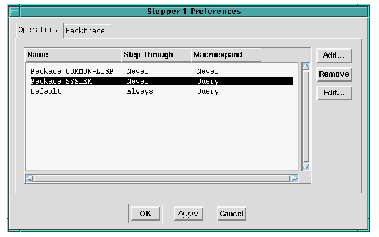






Figure 25.8 Stepper Preferences dialog


When reaching a function call you can use the Step Through Call command to step through the call into its definition. You can configure the Stepper to do this automatically, never do this or ask you which action to take.
Similarly when reaching a macro form you can macroexpand it (or not). You can configure the Stepper to macroexpand automatically, never macroexpand or ask you whether to macroexpand..
For a given symbol naming a function or macro, the action is determined by the preferences in the Operators tab. If the symbol is listed, then the corresponding action is taken. Otherwise, if the symbol's package is listed, then the corresponding action is taken. If neither the symbol nor its package are shown,. then the default action is taken.
For example, the default behavior on reaching your macro forms is to prompt for whether to macroexpand. To configure the Stepper such that macros defined in the
CL-USER
package are macroexpanded automatically, click the
Add...
button, enter
CL-USER
in the Name pane of the dialog, select
Always
in the
Expand macros
panel, click
OK
and click
OK
to dismiss the Stepper Preferences dialog.
To configure the Stepper such that it never steps through
my-function
, raise the Stepper preferences dialog again, click the
Add...
button and select the
Symbol
radio button. Enter
cl-user::my-function
in the Name pane of the dialog, select
Never
in the
Step through calls
panel, click
OK
and click
OK
to dismiss the Stepper Preferences dialog.